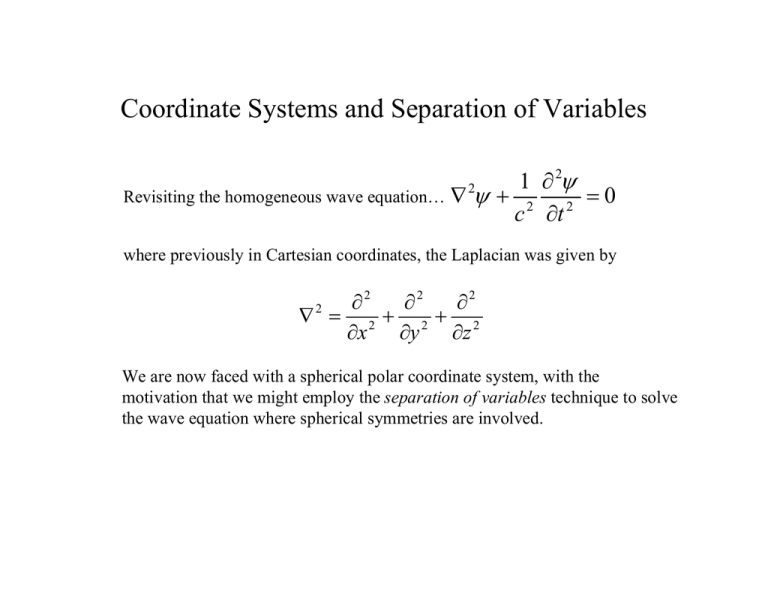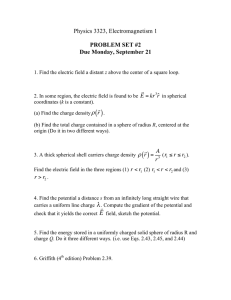Coordinate Systems and Separation of Variables ψ ∂ 1
advertisement

Coordinate Systems and Separation of Variables
1 ∂ 2ψ
Revisiting the homogeneous wave equation… ∇ ψ + 2
=0
2
c ∂t
2
where previously in Cartesian coordinates, the Laplacian was given by
∂2
∂2
∂2
∇ = 2+ 2+ 2
∂z
∂y
∂x
2
We are now faced with a spherical polar coordinate system, with the
motivation that we might employ the separation of variables technique to solve
the wave equation where spherical symmetries are involved.
Spherical Polar Coordinates
x = r sin θ cos φ
y = r sin θ sin φ
z = r cos θ
r = x2 + y2 + z 2
(r , φ ,θ )
θ
φ
r
r
y
[
θ = tan −1 x 2 + y 2 z
φ = tan −1 [ y x ]
]
2
1
1
1
∂
∂
∂
∂
∂
⎞
⎛
⎞
⎛
∇2 = 2 ⎜ r 2 ⎟ + 2
⎟+ 2 2
⎜ sin θ
∂θ ⎠ r sin θ ∂φ 2
r r ⎝ ∂r ⎠ r sin θ ∂θ ⎝
1 ∂⎛ 2 ∂ ⎞
⎟
Assuming variations only in r gives… ∇ = 2 ⎜ r
r r ⎝ ∂r ⎠
2
Thus for a vibrating sphere, we can say immediately that the relevant wave equation
is given by the following form of the Helmholtz equation in terms of r only…
⎡ 1 ∂ ⎛ 2 ∂ ⎞ 2⎤
⎢ r 2 r ⎜ r ∂r ⎟ + k ⎥ψ (r ) = 0
⎝
⎠
⎣
⎦
Which is known to have the two solutions…
⎧ ( A / r ) exp(ikr )
ψ (r ) = ⎨
⎩( B / r ) exp(−ikr )
(Makes sense as the field
decreases with r as we expect)
As we want to consider the sphere as the only source in the medium (radiation
condition), we can discard the second solution, which is actually converging on
the sphere, instead of propagating away from it – as must be the case.
Consider a sphere with a surface normal velocity
with a sinusoidal time dependence…
a
Time
Standing wave as the sum of two traveling waves
dt=pi/20;
for t1=0:dt:20*pi
% Displacement field
u=A*exp(i*k.*r0).*(i*k-1./r0);
u=u+A*exp(i*-k.*r0).*(i*-k-1./r0);
u=u*exp(-i*t1);
xpos=x0+real(u).*x0./r0;
ypos=y0+real(u).*y0./r0;
plot(xpos,ypos,'r.')
title('STANDING WAVE DISPLACEMENT FIELD')
axis equal
pause(.01);
end
Multipoles in a plane
Monopole
Dipole
Quadrupole
Spherical Harmonics
Lump together azmuthal and elevation dependence to arrive at
spherical harmonics…
Ynm (θ , φ ) ≡
(2n + 1) (n − m)! m
Pn (cos θ ) exp imφ
4π (n + m)!
Various dipole orientations in terms of
Spherical Harmonics
Re[Y11 ]
Im[Y11 ]
[Y10 ]
Various quadrupole orientations in terms of
Spherical Harmonics
Im[Y21 ]
Im[Y22 ]
Re[Y21 ]
Propagating fields from spherical boundaries
∞
p (r ,θ , φ ) = ∑
n=0
hn ( kr ) n m
m
*
′
′
′
′
Y
(
θ
,
φ
)
p
(
a
,
θ
,
φ
)
Y
(
θ
,
φ
)
dΩ ′
∑
n
n
∫
hn ( ka ) m = − n
Where the hn are traveling wave solutions
⎛π ⎞
hn(1) ( x) ≡ jn ( x) + iyn ( x) = ⎜ ⎟
⎝ 2x ⎠
1
⎛π ⎞
hn( 2 ) ( x) ≡ jn ( x) − iyn ( x) = ⎜ ⎟
⎝ 2x ⎠
1
2
2
[J
n +1 2
( x) + iYn +1 2 ( x)
[J
n +1 2
( x) − iYn +1 2 ( x)
]
]






